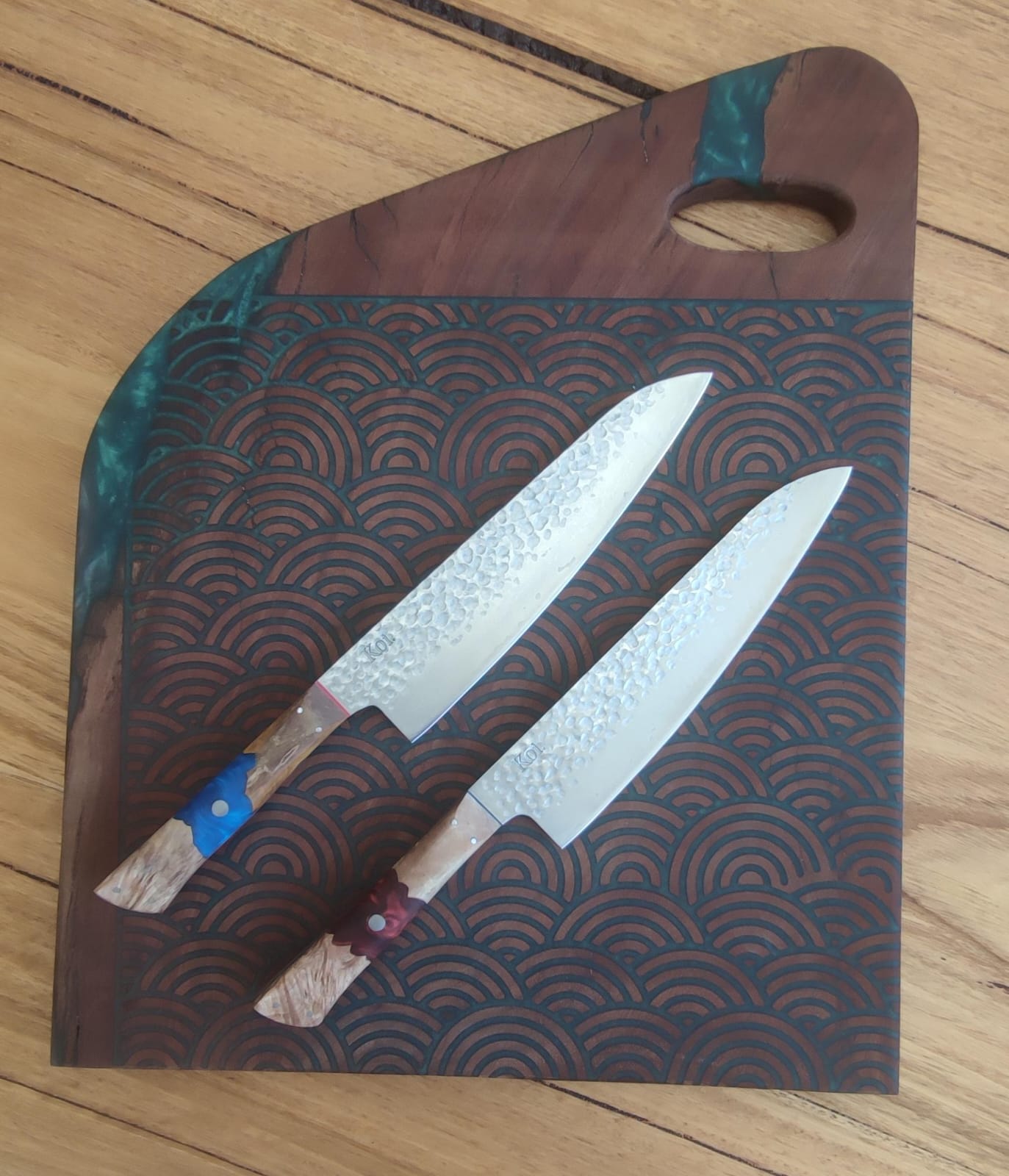Welcome to a comprehensive guide on the impact of blade thickness on knife performance. If you've ever wondered how blade thickness influences a knife's balance, weight, and overall functionality, you've come to the right place.
In this article, we will dive into the world of blade thickness and its profound implications for different types of knives.
Whether you're a passionate knife enthusiast or a discerning buyer looking for the perfect blade, the insights and expert tips below will help you navigate the realm of blade thickness and make informed decisions.
How Blade Thickness Affects Knife Balance
Centre of Gravity
Blade thickness significantly influences the knife's centre of gravity. Thicker blades shift the centre of gravity toward the edge, resulting in a handle-heavy balance.
In contrast, thinner blades position the centre of gravity closer to the handle, creating a more neutral balance.
Handling and Manoeuvrability
Thicker blades may hinder handling and manoeuvrability, as they can feel less agile and more cumbersome in hand. On the other hand, thinner blades offer enhanced manoeuvrability and allow for precise and intricate cuts with greater ease.
Influence of Blade Thickness on Weight and Control
Relationship between Thickness and Weight
Blade thickness directly impacts the weight of a knife. Thicker blades tend to be heavier, affecting control and fatigue during prolonged use. Thinner, lighter blades offer increased control and reduce strain on the hand and wrist.
Control and Precision in Cutting
The thickness of the blade affects the level of control and precision achievable during cutting tasks. Thinner blades excel in tasks that require intricate and delicate cuts, allowing for improved control and fine-tuned movements. Thicker blades, while sacrificing some precision, excel in heavy-duty tasks that require durability and resilience.
Blade Thickness for Different Knife Types and Uses
Regarding blade thickness, different knife types, and uses call for specific considerations to optimise performance and functionality; let's explore the ideal blade thickness for various tasks:
Thin Blades for Precision Tasks
Slicing and Filleting Knives: These knives excel in delicate slicing tasks like slicing through raw fish or creating thin, precise cuts. Opt for a thin blade with excellent flexibility and a sharp edge for clean and controlled slicing.

Paring and Utility Knives: Designed for intricate tasks like peeling, trimming, and cutting, thin-bladed paring and utility knives offer precision and manoeuvrability. A thin blade enhances agility, allowing you to navigate tight spaces effortlessly.
Medium Thickness for Versatility
Chef's Knives: A medium-thickness blade balances durability and precision. Chef's knives benefit from a versatile blade thickness, enabling efficient chopping, slicing, and dicing of various ingredients, making them a go-to-choice for professional kitchens.

Santoku Knives: Originating from Japan, Santoku knives feature a medium-thickness blade suitable for versatile use. The blade's width provides stability for cutting larger items, while the thinness towards the edge ensures precision and clean cuts.

Thick Blades for Durability and Heavy-Duty Tasks
Cleavers and Butcher Knives: These robust knives are designed for heavy-duty tasks like cleaving through bones and tough cuts of meat. A thick blade ensures durability, providing the necessary strength and force for such demanding tasks.

Survival and Tactical Knives: In terms of survival and tactical situations, thick blades are preferred. They offer durability and resilience for wood splitting, prying, and other demanding outdoor applications.

Tips for Choosing the Right Blade Thickness
When selecting a knife, considering the intended purpose and use is crucial in determining the optimal blade thickness. Here are some essential tips to help you choose the right blade thickness for your needs:
Consideration of Knife Purpose and Intended Use
Different tasks require varying blade thicknesses. A thinner blade provides finesse and precision for delicate slicing and precision tasks, such as filleting or paring. Conversely, heavy-duty tasks like cleaving or butchering benefit from thicker blades that offer durability and strength.
Balancing Thickness with Other Knife Attributes
Blade thickness should be considered with other knife attributes, such as edge geometry and sharpness. A thinner blade paired with a finely honed edge can enhance slicing performance, while a thicker blade may require a more robust edge for durability.
Edge Geometry and Sharpness
Blade thickness influences the geometry of the cutting edge. Thinner blades excel at producing finer, razor-sharp edges, ideal for intricate tasks. Thicker blades, however, can handle more abuse and may retain their sharpness longer under heavy use.
Handle Design and Ergonomics
The blade thickness should also complement the handle design and ergonomics. A thicker blade may require a handle with a larger grip for better control and comfort during heavy-duty tasks. Conversely, a thinner blade may pair well with a lighter, slimmer handle for precision tasks.
Testing and Evaluating Blade Thickness
Engaging in hands-on evaluation techniques is crucial to truly understand the impact of blade thickness on knife performance. By conducting cutting performance tests and assessing the comfort and feel of a knife in hand, you can make informed decisions regarding blade thickness selection.
Cutting Performance Tests
Performing cutting tests with knives of different blade thicknesses can provide valuable insights. Assess factors such as slicing, chopping, and precision cutting capabilities. Note how different thicknesses perform with various materials, such as fruits, vegetables, meats, or tougher ingredients.
Comfort and Feel in Hand
Comfort and ergonomics play a vital role in knife performance. When evaluating blade thickness, consider how it feels in your hand during prolonged use. Pay attention to the knife's balance, grip, and overall manoeuvrability. This evaluation helps determine the thickness best suits your preferences and cutting techniques.
Learning from Experts and Reviews
Gain insights from professionals in the culinary industry and fellow knife enthusiasts. Expert chefs often offer valuable advice on blade thickness based on their experience. Additionally, user reviews and recommendations can provide real-world perspectives on how blade thicknesses perform in various scenarios.
Professional Chefs' Insights
Professional chefs bring a wealth of knowledge regarding blade thickness preferences. Explore interviews, articles, and online forums to learn from their expertise. They can provide valuable insights into how different thicknesses impact cutting techniques, efficiency, and overall performance.
User Reviews and Recommendations
Reading user reviews and recommendations can provide a diverse range of perspectives. Look for patterns and consensus regarding blade thickness preferences for different culinary tasks. Individual preferences may vary, but user feedback can provide valuable guidance.
Conclusion
The impact of blade thickness on knife performance must not be overlooked. Throughout this article, we have explored how blade thickness affects balance, weight, and overall performance.
Thin blades offer precision, while medium thickness provides versatility.
Thick blades excel in durability and heavy-duty tasks.
When choosing the right blade thickness, consider the intended use and balance it with other knife attributes. Experimentation and learning from experts and reviews can further guide your decision.
Remember, the right blade thickness can elevate your cutting prowess and make every culinary endeavour pleasurable.




